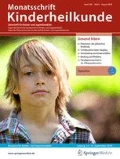Zusammenfassung
Der Hodenhochstand ist mit etwa 3% aller männlichen Neugeborenen die häufigste angeborene Fehlbildung bei Jungen. Jüngere Untersuchungen zeigen eine geringe Rate des Spontandeszensus von nur 7% im Alter von 1 Jahr. Unbehandelt wird der Maldescensus testis das Risiko späterer Infertilität erhöhen. Zudem ist er mit einem erhöhten Risiko für Hodentumoren assoziiert. Differenzialdiagnostisch kann der Hodenhochstand in seltenen Fällen Ausdruck einer zugrunde liegenden genetischen oder hormonellen Erkrankung sein. Bei nicht tastbaren Hoden, bei komplexen Fehlbildungssyndromen oder bei genitalen Fehlbildungen ist deshalb immer eine weiter gehende laborchemische und bildgebende, in einigen Fällen auch chirurgische Diagnostik indiziert; sie muss gegebenenfalls auch die molekulargenetische Klärung des zu Grunde liegenden Defektes umfassen. Die Planung der Differenzialdiagnostik sollte dann in interdisziplinärer Koordination zwischen pädiatrischen Endokrinologen, Humangenetikern und Kinderchirurgen erfolgen.
Abstract
Cryptorchidism is the most frequent malformation in boys occurring in up to 3% of male newborns. Recent investigations demonstrated a relatively low rate of spontaneous testicular descent of 7% at the age of 1 year. Untreated cryptorchidism is associated with a high risk of male infertility. Moreover, the risk of developing testicular cancer is significantly elevated. In rare cases, cryptorchidism can be a symptom of an underlying hormonal or genetic disease. Therefore, extended diagnostic procedures are indicated in all subjects in whom the testes are not palpable, when associated complex malformations are present, and in cases with genital abnormalities. Diagnostic procedures include determination of gonadal hormones, imaging procedures, and sometimes surgical exploration, as well as molecular genetic analysis of the underlying defect. An interdisciplinary approach is warranted for these specific cases involving a pediatric endocrinologist, a clinical geneticist as well as a pediatric surgeon.

Literatur
Wenzler DL, Bloom DA, Park JM (2004) What is the rate of spontaneous testicular descent in infants with cryptorchidism? J Urol 171:849–851
Hutson JM, Hasthorpe S, Heyns CS (1997) Anatomical and functional aspects of testicular descent and cryptorchidism. Endocr Rev 18:259–280
Lee MM, Donahoe PK (1993) Müllerian inhibiting substance: a gonadal hormone with multiple functions. Endocr Rev 14:152–164
Ivell R, Hartung S (2003) The molecular basis of cryptorchidism. Mol Hum Reprod 9:175–181
Boisen KA, Kaleva M, Main KM et al. (2004) Difference in prevalence of congenital cryptorchidism in infants between two Nordic countries. Lancet 363:1264–1269
Yamaguchi T, Kitada S, Osada Y (1991) Chromosomal anomalies in cryptochridism and hypospadias. Urol Int 47:60–63
Foresta C, Ferlin A (2004) Role of INSL3 and LGR8 in cryptorchidism and testicular functions. Reprod Biomed Online 9:294–298
Köhler B, Pienkowski C, Audran F et al. (2004) An N-terminal WT1 mutation (P181S) in an XY patient with ambiguous genitalia, normal testosterone production, absence of kidney disease and associated heart defect: enlarging the phenotypic spectrum of WT1 defects. Eur J Endocrinol 150:825–830
Klonisch T, Fowler PA, Hombach-Klonisch S (2004) Molecular and genetic regulation of testis descent and external genitalia development. Dev Biol 270:1–18
Tomiyama H, Sasaki Y, Huynh J et al. (2005) Testicular descent, cryptorchidism and inguinal hernia: the Melbourne perspective. J Pediatr Urol 1:11–25
Albers N, Ulrichs C, Glüer S et al. (1997) Etiologic classification of severe hypospadias. Implications for prognosis and management. J Pediatr 131:386–392
Interessenkonflikt:
Der korrespondierende Autor versichert, dass keine Verbindungen mit einer Firma, deren Produkt in dem Artikel genannt ist, oder einer Firma, die ein Konkurrenzprodukt vertreibt, bestehen.
Author information
Authors and Affiliations
Corresponding author
Rights and permissions
About this article
Cite this article
Hiort, O., Wünsch, L. & Holterhus, PM. Differenzialdiagnostische Überlegungen beim Hodenhochstand. Monatsschr Kinderheilkd 153, 430–435 (2005). https://doi.org/10.1007/s00112-005-1131-4
Issue Date:
DOI: https://doi.org/10.1007/s00112-005-1131-4

